
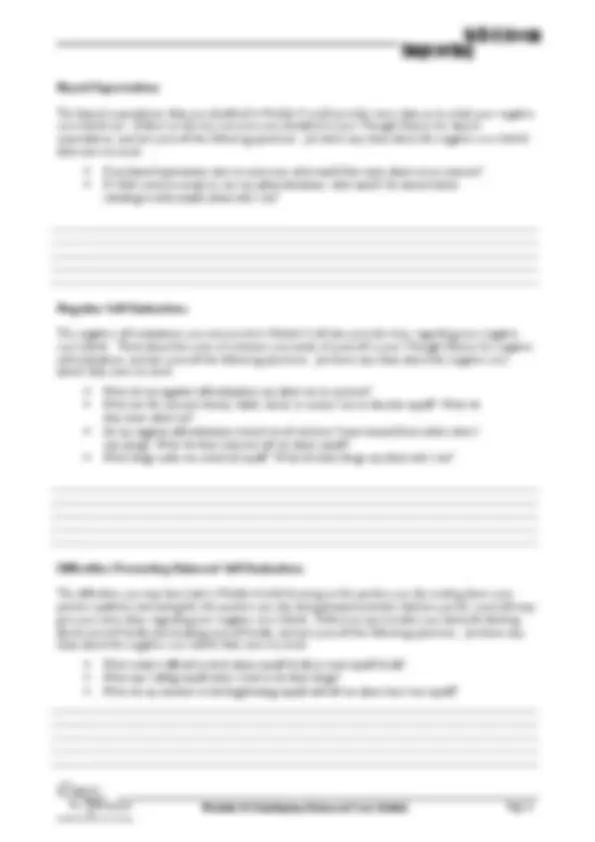
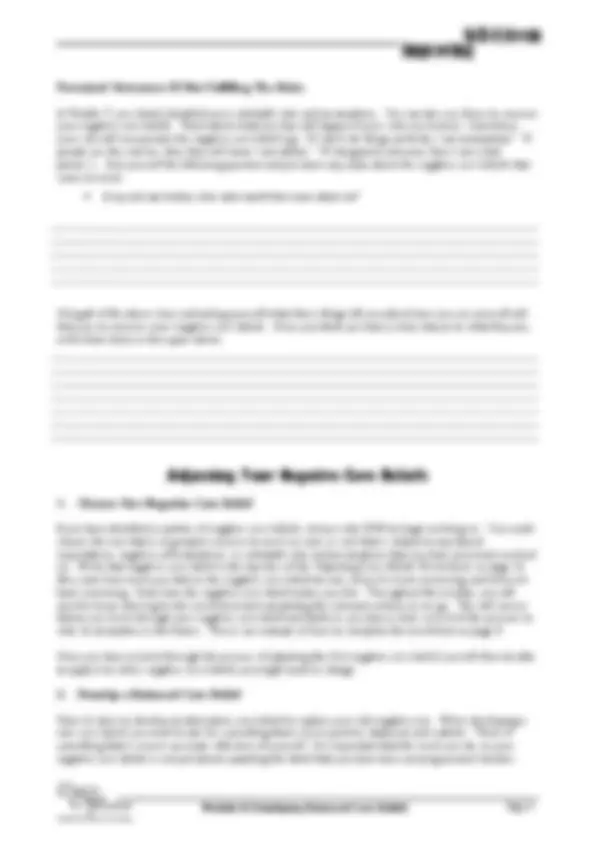
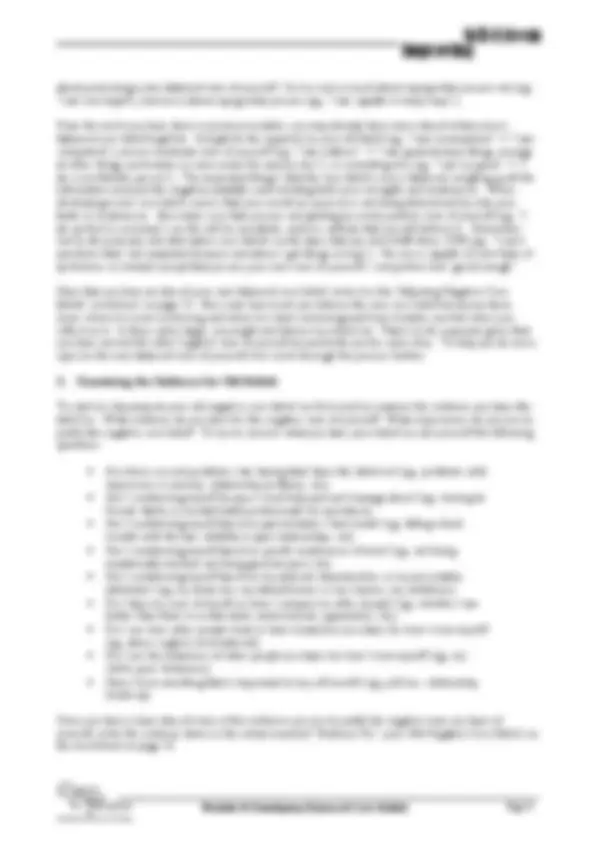

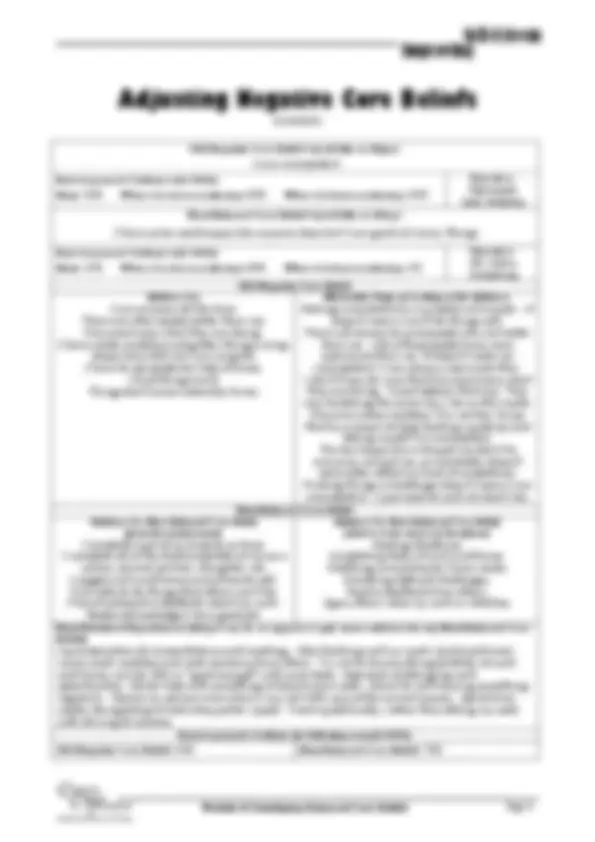
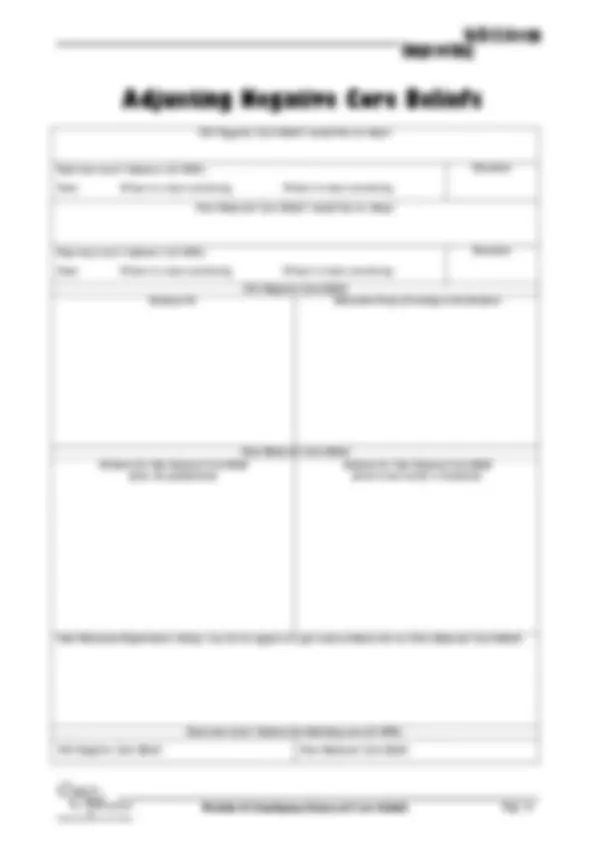


Study with the several resources on Docsity

Earn points by helping other students or get them with a premium plan


Prepare for your exams
Study with the several resources on Docsity

Earn points to download
Earn points by helping other students or get them with a premium plan
Community
Ask the community for help and clear up your study doubts
Discover the best universities in your country according to Docsity users
Free resources
Download our free guides on studying techniques, anxiety management strategies, and thesis advice from Docsity tutors
A module from the 'Improving Self-Esteem' series, focusing on developing balanced core beliefs to overcome negative self-beliefs. It includes identifying negative core beliefs, adjusting them, and evaluating the impact. The process involves examining evidence, evaluating beliefs, and experimenting with new behaviors.
What you will learn
Typology: Study notes
1 / 12

This page cannot be seen from the preview
Don't miss anything!







Page 1
C C I
entre for linical nterventions (^) Module 8: Developing Balanced Core Beliefs
Introduction 2 Identifying Your Negative Core Beliefs 2 Adjusting Your Negative Core Beliefs 4 An Ongoing Process 8 Adjusting Your Negative Core Beliefs (Example) 9 Worksheet: Adjusting Your Negative Core Beliefs 10 Module Summary 11 About This Module 12
Page 2
C C I
entre for linical nterventions (^) Module 8: Developing Balanced Core Beliefs
We have now come to the final step in tackling low self-esteem – changing the negative core beliefs you have about yourself. In earlier modules, you learned how to tackle the negative unhelpful thoughts you might have in day-to-day situations, which sprout from your negative core beliefs. In Module 7, you learned how to change the unhelpful rules and assumptions that have kept your negative core beliefs intact. All of these previous modules have put you in a strong position to now directly tackle the negative core beliefs that are at the root of your low self-esteem. All the hard work you have done so far has been undermining your negative core beliefs, shaking the ground beneath them, and sowing the seed of doubt as to how accurate they are. So let’s finish the job, and focus on adjusting those negative core beliefs – from negative and biased, to balanced and realistic.
Remember, your negative core beliefs reflect the negative, broad, and generalised judgements you have made about yourself, based on some negative experiences you might have had during your earlier years. Based on the work you have done in the earlier modules, you may already know what those beliefs are and you may have begun to question them. However, let’s really focus on this now.
If you are not clear as to what your negative core beliefs are as yet, you need to first pin them down and identify them, before you can start changing them. Reflecting on the work you have already done will provide information and clues as to what your negative core beliefs are. To uncover those negative core beliefs, you will need to think about the implications of the specific clues and information you already have, that is, think about what they say about the overall view you have of yourself. Important questions to ask yourself throughout this ‘identification’ process are: What does this information mean about me as a person? What does this clue say about who I am? Asking yourself these questions will help you uncover your negative core beliefs from specific thoughts and experiences you have already identified.
Below are the various clues and information you can use to identify your negative core beliefs. Go through each of them, and see if you can discover the specific negative core beliefs that ring true for you.
Negative Life Experiences
The negative life experiences that you identified in Module 2 as contributing to the development of your low self-esteem could provide clues as to what your negative core beliefs are. Reflect on these experiences and ask yourself the following questions. Jot down any ideas about the negative core beliefs that come to mind.
Page 4
C C I
entre for linical nterventions (^) Module 8: Developing Balanced Core Beliefs
Perceived Outcomes Of Not Fulfilling The Rules
In Module 7, you clearly identified your unhelpful rules and assumptions. You can also use these to uncover your negative core beliefs. Think about what you fear will happen if your rules are broken. Sometimes your rule will incorporate the negative core belief (eg., “If I don’t do things perfectly, I am incompetent, ” “If people see the real me, then they will know I am inferior, ” “If I disappoint someone, then I am a bad person. ”). Ask yourself the following question and jot down any ideas about the negative core beliefs that come to mind.
Using all of the above clues and asking yourself what these things tell you about how you see yourself will help you to uncover your negative core beliefs. Once you think you have a clear idea as to what they are, write them down in the space below.
1. Choose One Negative Core Belief
If you have identified a number of negative core beliefs, choose only ONE to begin working on. You could choose the one that is of greatest concern to work on now or one that is related to any biased expectations, negative self-evaluations, or unhelpful rules and assumptions that you have previously worked on. Write that negative core belief in the top box of the ‘Adjusting Core Beliefs Worksheet’ on page 10. Also note how much you believe the negative core belief at now, when it’s most convincing, and when it’s least convincing. Note how the negative core belief makes you feel. Throughout this module, you will need to keep referring to this worksheet and completing the relevant sections as we go. This will ensure that as you work through your negative core belief and tackle it, you have a clear record of this process to refer to at anytime in the future. There’s an example of how to complete the worksheet on page 9.
Once you have worked through the process of adjusting this first negative core belief, you will then be able to apply it to other negative core beliefs you might want to change.
2. Develop a Balanced Core Belief
Now it’s time to develop an alternative core belief to replace your old negative one. When developing a new core belief, you want to aim for something that is more positive, balanced, and realistic. Think of something that is a more accurate reflection of yourself. It is important that the work you do on your negative core beliefs is not just about squashing the belief that you have been carrying around, but also
Page 5
C C I
entre for linical nterventions (^) Module 8: Developing Balanced Core Beliefs
about promoting a new balanced view of yourself. So it is not so much about saying what you are not (eg., “I am not stupid”), but more about saying what you are (eg., “I am capable in many ways”).
From the work you have done in previous modules, you may already have some idea of what a more balanced core belief might be. It might be the opposite to your old belief (eg., “I am incompetent” ¤ “I am competent”), a more moderate view of yourself (eg., “I am a failure” ¤ “I am great at many things, average at other things, and weaker in some areas like anyone else”), or something else (eg., “I am no good” ¤ “I am a worthwhile person”). The important thing is that the new belief is more balanced, weighing up all the information (not just the negative) available, and including both your strengths and weaknesses. When developing a new core belief, ensure that your worth as a person is not being determined by only your faults or weaknesses. Also make sure that you are not painting an overly positive view of yourself (eg., “I am perfect in everyway”), as this will be unrealistic, and it is unlikely that you will believe it. Remember not to discount any new alternative core beliefs on the basis that you don’t fulfil these 100% (eg., “I can’t put down that I am competent because sometimes I get things wrong.”). No one is capable of such feats of perfection, so instead, accept that you are your new view of yourself – not perfect, but “good enough.”
Now that you have an idea of your new balanced core belief, write it in the ‘Adjusting Negative Core Beliefs’ worksheet’ on page 10. Also note how much you believe this new core belief at various times (now, when it is most convincing, and when it is least convincing) and how it makes you feel when you reflect on it. In these early stages, you might not believe it a whole lot. That is to be expected, given that you have carried the other negative view of yourself around with you for some time. To help you be more open to the new balanced view of yourself, let’s work through the process further.
3. Examining the Evidence for Old Beliefs
To start to chip away at your old negative core belief, we first need to examine the evidence you base this belief on. What evidence do you have for this negative view of yourself? What experiences do you use to justify this negative core belief? To try to uncover what you base your belief on, ask yourself the following questions:
Once you have a clear idea of some of the evidence you use to justify the negative view you have of yourself, write the evidence down in the column marked “Evidence For” your Old Negative Core Belief, on the worksheet on page 10.
Page 7
C C I
entre for linical nterventions (^) Module 8: Developing Balanced Core Beliefs
Evidence
In previous modules, we have discussed how when you have a core belief about yourself, you will tend to only pay attention to things that confirm your belief. Therefore, to enhance the new balanced view of yourself, you will need to start paying attention to evidence from the past and present that confirms this new view. You also need to be ready to pay attention to evidence that arises in the future that confirms this new view. On the ‘Adjusting Negative Core Beliefs’ worksheet, fill in past or present examples or experiences you have had that are consistent with your new balanced core belief. When doing this, pay attention to things that have happened that support this kinder view of yourself. Once you have done this, fill in the types of evidence likely to arise in the future, which will confirm your new balanced view. This will act as a reminder of what to be on the look out for, to help you strengthen this kinder view of yourself.
Experiments
The last part of adjusting your negative core beliefs involves behaving as if the new balanced view of yourself is true. At the moment it doesn’t sound very good, does it? But of course, it is true! It’s just that you might not quite believe it as yet. Do you agree? This is because you have been carrying around the negative core beliefs for a while. However, you are beginning to loosen their hold on you. Let’s loosen it further by changing how you behave and live your life! Ask yourself how someone who believed this kinder view of themselves might act or behave from day to day? How you can test out this new perspective you have of yourself? What things could you do to obtain more evidence for your new balanced core belief? What new experiences might further support this new perspective you are developing?
In general, to create new opportunities for more experiences that will support your new core belief will involve:
At a more specific level, think about exactly what you could do to ‘test-drive’ this new view of yourself. Exactly what new behaviours will you need to try out? How will you be behaving differently to before? Once you have some specific ideas about how to experiment with this new core belief, write these down in the “New Behaviour/Experiments” section of the ‘Adjusting Negative Core Beliefs’ worksheet.
5. Evaluating Your Beliefs
Now that you have been through the step-by-step process for adjusting your negative core beliefs, it is important to reflect on what impact this process has had on you. You can do this by re-rating how much you now believe your old negative core belief and compare it to how much you now believe your new balanced core belief. Complete these ratings at the bottom of the worksheet.
Page 8
C C I
entre for linical nterventions (^) Module 8: Developing Balanced Core Beliefs
It is important to remember that changing your core belief about yourself is a difficult task that might take some time and practice. It will involve revisiting the steps in this module a number of times, reflecting on what you have written, and perhaps adding more things. It will involve continually re-training your attention in everyday life so that you take note of all the future evidence that will arise to further support your new belief. It will involve behaving differently and using experiments to help accumulate more experiences and evidence for you new belief. It is an ongoing process. Remember, you have carried this old belief around for many years, so it will take some time to adjust it and embrace your new belief. However, you will find that if you continue to apply these strategies over time, your conviction in your old negative core beliefs will decrease and your conviction in your new balanced core beliefs will rise.
Page 10
entre for linical nterventions (^) Module 8: Developing Balanced Core Beliefs
Old Negative Core Belief I would like to Adjust
Rate how much I believe it (0-100%):
Now: When it is most convincing: When it is least convincing:
Emotions
New Balanced Core Belief I would like to Adopt
Rate how much I believe it (0-100%):
Now: When it is most convincing: When it is least convincing:
Emotions
Old Negative Core Belief Evidence For Alternative Ways of Looking at the Evidence
New Balanced Core Belief Evidence For New Balanced Core Belief (from the past/present)
Evidence For New Balanced Core Belief (what to look out for in the future)
New Behaviour/Experiments (things I can do to support or gain more evidence for my New Balanced Core Belief):
Rate how much I believe the following now (0-100%)
Old Negative Core Belief: New Balanced Core Belief:
Page 11
C C I
entre for linical nterventions (^) Module 8: Developing Balanced Core Beliefs
Develop a new understanding of the evidence on which you based your old beliefs Develop a new balanced core belief Identify evidence from the past and present that support this new belief Identify what evidence you need to look out for in future to support this new belief Behave and experiment in ways that confirm your new core belief
Coming up next … In the next module, you will be able to explore what healthy self- esteem is and put all the concepts in this infopax together.